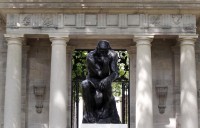 After a three-year, $9 million renovation of the grounds, museum and sculptures, the Rodin Museum in Philadelphia reopened Friday restored to the original 1929 vision of its architect Paul Crét. The Rodin Museum was founded by movie theater magnate Jules Mastbaum who in 1926 hired the French-born Crét and landscape architect Jacques Gréber to create a sophisticated Beaux Art building with a formal French garden that would showcase, both indoors and out, the sculptures by Auguste Rodin he’d been collecting since he was first introduced to the artist’s work in Paris in September 1924.
After a three-year, $9 million renovation of the grounds, museum and sculptures, the Rodin Museum in Philadelphia reopened Friday restored to the original 1929 vision of its architect Paul Crét. The Rodin Museum was founded by movie theater magnate Jules Mastbaum who in 1926 hired the French-born Crét and landscape architect Jacques Gréber to create a sophisticated Beaux Art building with a formal French garden that would showcase, both indoors and out, the sculptures by Auguste Rodin he’d been collecting since he was first introduced to the artist’s work in Paris in September 1924.
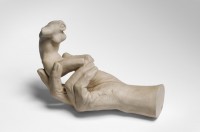 Although Mastbaum died that same year, when the museum was completed in 1929, his wife honored his commitment to gift it to the city of Philadelphia. Thus Philadelphia became home to the largest collection of Rodin’s works outside Paris, including more than 140 original marble sculptures, plaster studies and bronze castings made before and after Rodin’s death in 1917. (Most of the extant Rodin bronzes around the world were actually cast from his original stone and plaster work after his death.) There are also original prints, letters, books and over 600 drawings in the collection.
Although Mastbaum died that same year, when the museum was completed in 1929, his wife honored his commitment to gift it to the city of Philadelphia. Thus Philadelphia became home to the largest collection of Rodin’s works outside Paris, including more than 140 original marble sculptures, plaster studies and bronze castings made before and after Rodin’s death in 1917. (Most of the extant Rodin bronzes around the world were actually cast from his original stone and plaster work after his death.) There are also original prints, letters, books and over 600 drawings in the collection.
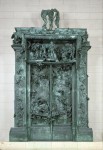 The bronze casting of The Gates of Hell, a set of monumental doors inspired by Dante’s Inferno that Rodin worked on for 37 years and for which he first created some of his most famous figures, like The Thinker, The Kiss, Adam and Eve, is one of three originals cast from Rodin’s plaster model in 1917. It was made specifically for Mastbaum. The Gates hold pride of place in the museum in the entrance gallery, emphasizing the connection between the doors and the later sculptures Rodin derived from them. A bronze of The Thinker stands watch outside the main entry to the museum.
The bronze casting of The Gates of Hell, a set of monumental doors inspired by Dante’s Inferno that Rodin worked on for 37 years and for which he first created some of his most famous figures, like The Thinker, The Kiss, Adam and Eve, is one of three originals cast from Rodin’s plaster model in 1917. It was made specifically for Mastbaum. The Gates hold pride of place in the museum in the entrance gallery, emphasizing the connection between the doors and the later sculptures Rodin derived from them. A bronze of The Thinker stands watch outside the main entry to the museum.
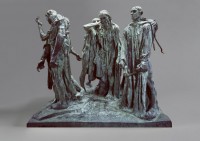 All of the other sculptures that were originally placed on the grounds have been returned to their original spots in the French garden. They had been brought inside in the late 1960s to protect them from the acid rain that had eaten away at their surfaces. Curators were able to restore the original finishes and to apply protective coatings that will keep the sculptures from suffering the same fate again. Only one piece, The Burghers of Calais, is still in need of refurbishment. It’s been put in place outside and conservators will work on it in situ.
All of the other sculptures that were originally placed on the grounds have been returned to their original spots in the French garden. They had been brought inside in the late 1960s to protect them from the acid rain that had eaten away at their surfaces. Curators were able to restore the original finishes and to apply protective coatings that will keep the sculptures from suffering the same fate again. Only one piece, The Burghers of Calais, is still in need of refurbishment. It’s been put in place outside and conservators will work on it in situ.
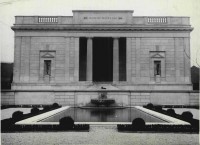 The museum building itself was also thoroughly restored to its period condition but with updated systems like brand new air conditioning for the first time in its life, something that will make summer vacation visits far more bearable. Restorers stripped off layers of paint and faux marble that had been applied in previous renovations to the inside walls. They returned the original paint colors and replicated the original linen wall coverings in the museum’s central gallery. They also removed the paint from wood architectural elements and restored them to their original finishes.
The museum building itself was also thoroughly restored to its period condition but with updated systems like brand new air conditioning for the first time in its life, something that will make summer vacation visits far more bearable. Restorers stripped off layers of paint and faux marble that had been applied in previous renovations to the inside walls. They returned the original paint colors and replicated the original linen wall coverings in the museum’s central gallery. They also removed the paint from wood architectural elements and restored them to their original finishes.
Sally Malenka, conservator of decorative arts and sculpture, spearheaded the archaeological dig into the museum’s past, discovering the original painted wall surfaces and other obliterated elements through examination of paint chips, Crét’s drawings and accounts, and contemporary newspaper descriptions.
“It’s interesting that for a building as recent as 1929, some of the history of what the original interior looked like is really not known,” Malenka said. “We had some old black-and-white photographs and some correspondence. So we knew there was fabric on the walls. We didn’t know at that time that the rooms were red, so there was a combination of looking for archival materials and other historical or contemporary accounts, and also investigating what the finishes were by what remained in situ.”
It’s astonishing how quickly current events become nebulous ancient history. Who’d have thought you’d need to do archaeological research to restore a museum that is only 83 years old.
The Rodin’s Museum website is excellent. You can browse pictures of the sculptures in the collection, or explore them grouped together in relevant themes.
For a fascinating voyage through The Gates of Hell, you simply must view this video from the Canal Educatif a la Demande (CED). Registration is free, and trust me, it is more than worth the price of admission. It’s a riveting story exceptionally well told.